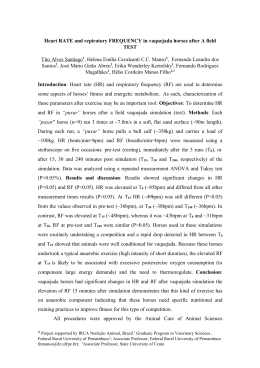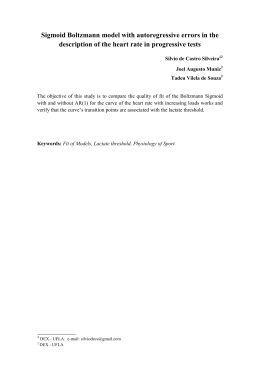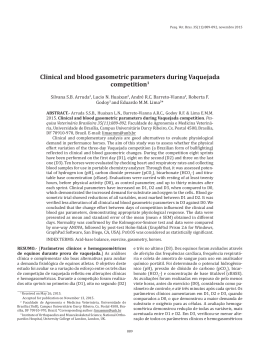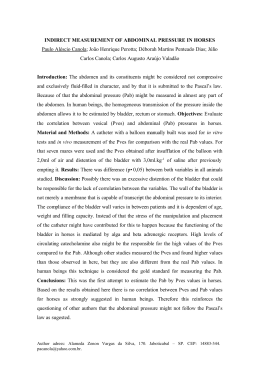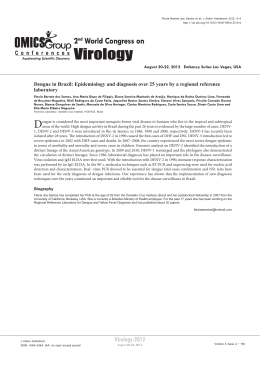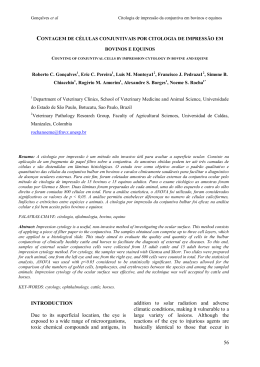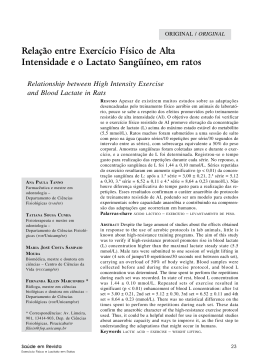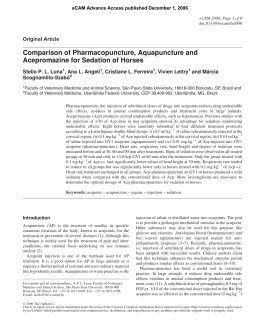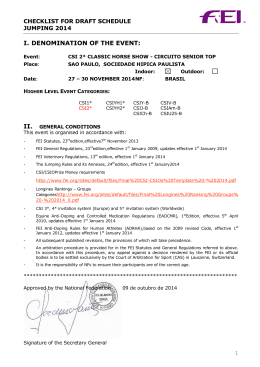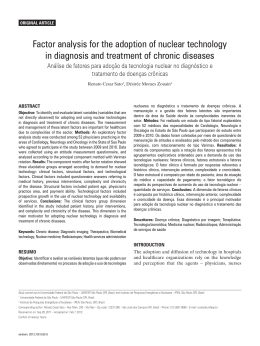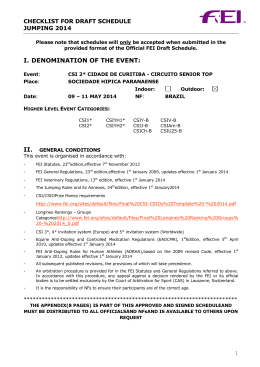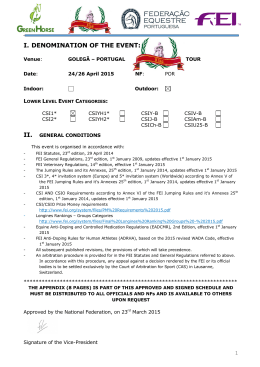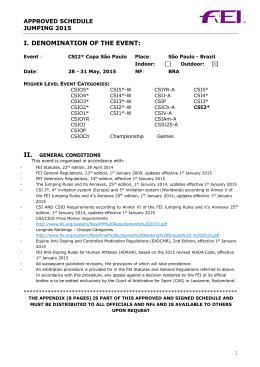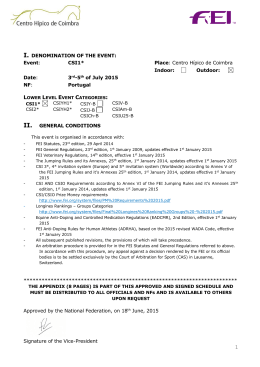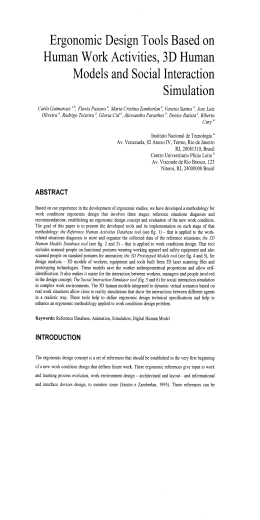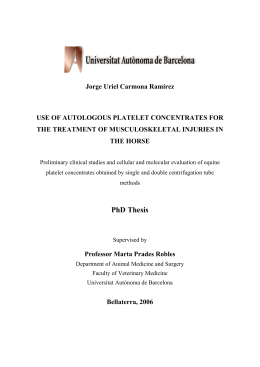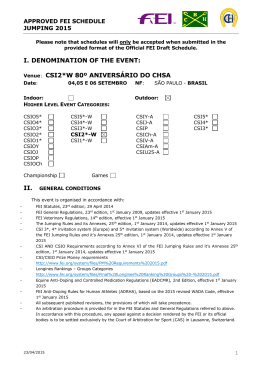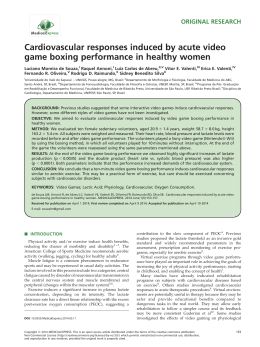PLENARY LECTURE Use of blood biochemistry for positive performance diagnosis of sport horses in practice A. LINDNER Arbeitsgruppe Pferd, Laurahöhe 14, D-45289 Essen, Germany SUMMARY RÉSUMÉ The measurement of many biochemical and other type of variables is done for performance diagnosis of sport horses. However, the term performance diagnosis in practice has different meanings. The parameter of differentiation between the meanings is the regularity of measurements. When variables are measured on a regular basis they provide formation for sports performance diagnosis (= positive performance diagnosis). When variables are measured sporadically they are used to give information for poor performance diagnosis of sport horses (=negative performance diagnosis). Most persons involved in performance diagnosis do the latter even though they believe they are doing the former. Variables shown to give some information about the likelihood of horses not competing successfully, thus providing information on negative sports performance (poor performance), do not seem to provide useful information for positive performance diagnosis. Also, variables allowing a distinction between untrained and trained horses are of no use for positive performance diagnosis. Positive performance diagnosis has to provide a means to discriminate between similarly trained horses at certain times during the training programme or the competitive season. The only single informative biochemical blood variable of benefit for positive performance diagnosis of sport horses in practice is lactate. However, two conditions to use it successfully for positive performance diagnosis have to be fulfilled : it has to be measured regularly in the same horse during standardized exercise, and a data base built with results of horses tested the same way is needed to compare the values and draw the conclusions on the competititve level and optimization of training programmes. Utilisation de la biochimie sanguine pour le diagnostic de performance positif des chevaux de sport en pratique. Par A. LINDNER. KEY-WORDS : performance - diagnosis - biochemistry blood - lactate - horses. MOTS-CLÉS : performance - diagnostic - biochimie sang - lactate - cheval. Revue Méd. Vét., 2000, 151, 7, 611-618 La mesure de nombreuses variables, biochimiques et autres, est pratiquée pour le diagnostic des performances chez les chevaux de sport. Cependant, le diagnostic des performances a différentes significations en pratique. Le paramètre de différenciation entre ces significations est la régularité des mesures. Quand les variables sont mesurées régulièrement, elles fournissent une information pour le diagnostic des performances sportives (= diagnostic de performance positif). Quand les variables sont mesurées de manière irrégulière, elles sont utilisées pour donner une information concernant le diagnostic des mauvaises performances des chevaux de sport (= diagnostic de performance négatif). C'est ce dernier qui est effectué par la plupart des personnes impliquées dans le diagnostic de performances, même si elles pensent effectuer le premier. Les variables qui semblent donner une information sur la probabilité que des chevaux n'effectuent pas correctement une compétition, donc fournissant une information négative (mauvais résultat), ne semble pas fournir d'information utile pour le diagnostic positif. De même, les variables permettant une distinction entre chevaux entraînés et non entraînés sont sans intérêt pour le diagnostic de performance positif. Le diagnostic de performance positif doit fournir un moyen de faire la différence entre des chevaux entraînés de la même manière à certaines périodes au cours de leur programme d'entraînement ou de la saison de compétition. La seule variable biochimique sanguine ayant une valeur informative pour le diagnostic de performance positif chez le cheval en pratique est le lactate. Cependant, deux conditions doivent être remplies pour l'utiliser correctement : il doit être mesuré régulièrement chez le même cheval pendant un exercice standardisé et une banque de données, construite avec les résultats de chevaux testés dans les mêmes conditions, est nécessaire pour comparer les valeurs et tirer des conclusions quant à l'aptitude à la compétition et à l'optimisation des programmes d'entraînement. 612 LINDNER (A.) Introduction For a long time, the measurement of many biochemical and other types of variable has been suggested to allow for an objective assessment of the competitive capability of sport horses [39, 41, 45, 48]. Many different variables are indeed supposedly measured for this purpose. This has been demonstrated with the results of the evaluation of a questionnaire answered by veterinarians and trainers working with sport horses in Germany, Austria, Italy and Switzerland during a series of six two-day practical courses on equine performance diagnosis in 1997-8. One of the questions addressed was : Which variable/s do you use for performance diagnosis of your horse/s at rest or during and after exercise ? Out of a total of about 150 course participants 76 answered the questions. The evaluation of the questionnaire showed that many different variables were being measured (figure 1), physiological variables more frequently than hematological and blood biochemical ones. Although this result is most likely biased because the practical courses were on performance diagnosis and training control with blood lactate measurements, only the measurement of lactate concentration in blood or plasma was done as often as the physiological variables. The reason for favouring the physiological variables was that their measurement was practical and veterinarians and trainers believed that it supplied them valuable additional information on health and performance of their horses. Blood or plasma lactate concentration was measured so often because it provided additional information on actual performance of a horse, and sometimes on health status as well. Another interesting result of the evaluation was that the large majority of the biochemical and hematological variables were measured in the horse under resting conditions (figure 1). In most cases, heart and respiratory rate were measured consecutively in horses at rest and after exercise, and blood for lactate analysis was preferentially taken after exercise, in most cases only once. The key question on the use of any variable for performance diagnosis is whether it provides the expected benefit (validity). Another questionnaire given to the participants of the performance diagnosis courses addressed the question "What do you mean with performance diagnosis ?". The evaluation showed that the meaning of performance diagnosis was very ambiguous. This result fully reflects the situation in practice. Discussions on the definition demonstrated that most participants meant to objectively evaluate actual or potential sports performance capacity. However, most of them admitted that they were measuring the variables when they felt that they needed information on the lack of expected sports performance capacity of their horses. Although sometimes it may be difficult to differentiate between terms there is one clear parameter of differentiation: regularity of measurement. When variables are measured on a regular basis in horses they provide information for sports performance diagnosis (= positive performance diagnosis). When variables FIGURE 1. — Variables measured for performance diagnosis (76 veterinarians and trainers). Revue Méd. Vét., 2000, 151, 7, 611-618 USE OF BLOOD BIOCHEMISTRY FOR POSITIVE PERFORMANCE DIAGNOSIS OF SPORT HORSES IN PRACTICE are measured sporadically, in some cases even only once in life, they are used to attempt to add information for poor performance diagnosis of sport horses (= negative performance diagnosis). Some of the blood or plasma biochemical variables which have been shown to inform about the likelihood of not competing successfully, thus providing information on negative sports performance, are : Bilirubin (when increased [48]), Gamma-glutamyltranferase (when increased [46]), Creatine-phosphokinase (when increased [1, 26, 43, 45]), Potassium (when above 4.0 mmol/l [50]), and Phosphate (when increased [16]). But nobody has demonstrated that measuring these variables also may allow for positive performance diagnosis. In literature an innumerable amount of references are found in which authors describe or at least allude to the benefit of certain biochemical and other variables for discriminating between untrained and trained horses (table I). We have to be aware that this is not what matters in positive performance diagnosis of sport horses. Positive performance diagnosis has to provide trainers, riders and veterinarians with a means to discriminate between similarly trained horses at certain times during the training programme or the competitive season. Through continuous application of positive performance diagnosis it is possible to help find an answer to the question why a horse is better than others: Is it the genetic make-up ? Or is the environment (training and health management) ? Fine, but with which variable/s can positive performance diagnosis be provided ? A search through literature for studies on the validity of biochemical variables for positive performance diagnosis demonstrates that there are not many. This also holds for other types of variable. The vast majority of variables reacts to exercise, but this does not ensure that they are also suitable for positive performance diagnosis of sport horses. We have examined the potential of several biochemical variables for positive performance diagnosis in sport horses. For this purpose, on one occassion, 15 standardbred race horses (six were two-year-olds and the others between 3 and 6 years old) were submitted to a standardized exercise test (SET) on a racetrack. Conditions were kept as similar as possible for all horses during the testing day [31, 32]. The SET consisted of four or more runs depending on when the blood lactate concentration of a horse exceeded 4 mmol/l. Speed in the first run was 6 m/s, and it was increased by 1 m/s for each run. Blood samples were taken within 30 seconds after each run from jugular vein and analyzed for Creatine-kinase (CK), Aspartate-aminotranferase (AST), Lactate dehydrogenase (LDH), Cortisol, Alanine, Free Fatty Acids and Thiobarbituric Acid-like reactive Substances (TBArS). To determine whether a variable allowed a distinction between horses of different performance capability we first plotted running speed for each horse in each run against the measured value of a variable. Performance capability was defined in the horses older than 2 years by their actual racing record. Horses of two years of age had not yet raced but were in full training. Only blood lactate concentration allowed clearly to discriminate between faster and slower horses, and it was also possible to distinguish between most of the twoyear-old horses and the older ones (figure 2). All the other variables measured did not allow for distinguishing discriminating between horses of differing racing records, and if at all only partially between horses two-years old and older. The graph for TBArS is presented as an example of this type of variable (figure 3). Further analysis of data among groups demonstrated that the values of Lactate, Cortisol and TBArS, and to some extent also CK, after the fourth run allowed to distinguish between two-year-old horses and older ones. For this purpose the median (for CK, AST and LDH) or mean value of each group for each variable after the fourth run was compared * = after exercise ; in all other references cited blood was taken from horses under resting conditions TABLE I. — Studies in which the use of biochemical variables other than blood or plasma lactate was investigated for differentiation between trained and untrained horses (only variables which were cited in at least two independent studies were considered). Revue Méd. Vét., 2000, 151, 7, 611-618 613 614 LINDNER (A.) FIGURE 2. — Concentration of lactate in blood of two year old and older Standardbred racehorses during a standardized exercise test (15 horses). FIGURE 3. — Concentration of TBArS in blood of two year old and older Standardbred racehorses during a standardized exercise test (15 horses). Revue Méd. Vét., 2000, 151, 7, 611-618 USE OF BLOOD BIOCHEMISTRY FOR POSITIVE PERFORMANCE DIAGNOSIS OF SPORT HORSES IN PRACTICE statistically. The fourth run was selected because it was the most intensive one run by all horses tested, and it was expected that at the highest comparable work stress distinguish between horse groups would be easiest (table II). The results demonstrated very clearly that only blood lactate, as well as plasma TBArS and plasma cortisol concentration, allowed to significantly distinguish between the two age groups´ build. The really important step of positive performance diagnosis is to inform accurately about the actual competitive level of a horse. To examine the validity of the variables for this purpose the relation of values of the variables measured after a defined workload and the racing record of the horses tested was examined with linear and exponential regression analysis. The racing record is defined internationally as time needed to run a kilometre (or a mile), and is used to objectively compare performance of Standardbred horses. Again the value chosen for the variables measured was the one after the fourth run of SET. The results of the regression analysis demonstrated that only the blood lactate concentration after the fourth run gave a reasonable explanation for the racing record (linear regression ; r2 = 0.89 ; p = 0.001 ; n = 7). Another approach to examine the dependence of biochemical or other variables from competitive performance parameters like racing record is to derive parameters which describe the development of the values of a variable with increasing workload. Out of the measured biochemical variables only the blood lactate concentration of each horse had a positive exponential relation with the speed of exercise. The other variables were not always related exponentially or linearly in all horses with speed of exercise. Thus a parameter to describe the relation between these variables and speed was not calculated. Only the blood lactate concentration measured after each run was plotted against running speed to derive mathematically v4 from the blood lactate-running speed relation (v4 = velocity run under defined conditions inducing 4 mmol/l blood lactate concentration). This parameter is used widely to examine effects of conditioning and to diagnose positive performance of sport horses [13, 20, 24, 37]. The result was that v4 was linearly correlated with the race record of the Standardbred horses tested (figure 4). This negative correlation is corroborated regularly in our tested horses. Our conclusion is that v4 and therefore lactate measu- Best racing time (minutes : seconds for 1 km, only seconds shown) TABLE II. — Validity of certain biochemical variables for differentiation of age groups in Standardbred horses (6 two-year old horses and 9 older ones) comparing values after fourth run of a standardized exercise test. FIGURE 4. — Relation between best actual racing time and v4 of Standardbred Trotters (n = 7 ; r = 0.77 ; p < 0.01). Revue Méd. Vét., 2000, 151, 7, 611-618 615 616 LINDNER (A.) TABLE III. — The services of positive performance diagnosis of sport horses. rement in blood or plasma (not interchangeable [30, 51]) is actually the best parameter or variable to offer veterinarians and trainers the service of positive performance diagnosis of sport horses. This conclusion is supported by studies done by several other authors where correlations between competitive success and v4 or blood/plasma lactate concentration has been described (for endurance riding DEMONCEAU [15], ERICKSON et al [17] ; for three day eventing GALLOUX [20] ; for Standardbred racehorses CASINI and GREPPI [11], COUROUCÉ [13], KRZYWANEK [28], PONCHARD [38] ; for Thoroughbred racing BAYLY et al [5], DAVIE [14], EVANS et al [19], HARKINS et al [24], PONCHARD [38] ; for Quarterhorse racing ERICKSON et al [18]). No other variable has shown so frequent and so good a relation with competitive performance. Nowadays the practical application of positive performance diagnosis, once it has been recognized that this is the service wanted, is not a matter of which variable should be used but how we use the measurement of blood/plasma lactate concentration for this purpose. The participants of the courses on performance diagnosis and training guidance expressed their interest in this service. Of the above mentioned authors, COUROUCÉ [13], DAVIE [14] and we ourselves offer the service of positive performance diagnosis in practice. The measurement of lactate in blood or plasma is a routine inexpensive procedure, and the testing procedures are no mystery either. Although each group uses different exercise test prescriptions, we seem to be providing useful service to our clients. The bottleneck in providing positive performance diagnosis is that it is necessary to have a data base. No reference value can be formulated because v4 or lactate values depend on the test prescription, and the test prescriptions are influenced by many factors. The most important ones are track length and surface as well as horse type. For anybody wanting to offer the service it is necessary to realize that a data base is necessary to compare results of horses. The more specific and larger the data base for each client´s horses is the better the service that can be provided. As a matter in fact : it is the only way to provide satisfactorily the service. Most persons wanting to provide the service to a client do not explain to them sufficiently that to build a data base takes time, the longer • the less horses the client has or wants to be tested regularly, • the less different the competitive level of horses of a client is. The sports disciplines for which it is easiest to build up a data base are Standardbred and Thoroughbred/Quarterhorse racing. In many cases in these sports disciplines, one owner owns several horses, or several trainers and owners of horses in a race-track cooperate. But even for these sports disciplines it takes time before the service provides useful information (table III). Of the services offered the ranking of horses according to their actual competitive level is most quickly achievable. In practice this is a very useful service of positive performance diagnosis, especially in trot, pace and gallop racing where horse fluctuation within barns is high, and time to race horses short. The service supplies the trainer or veterinarian with additional and objective information on the actual performance capability of a "new" horse, of a horse recovering from injury, or of the development of a horse through training. The dream of all sport horse owners is to be able to tell at an early stage whether a horse will be fast or not. Potential positive performance diagnosis may give further information for this matter. For this purpose horses need to be regularly tested at an early age. Very many factors play a role in the outcome of elite athletes. The work published by BARREY et al [4] is very promising. They found a positive genetical relation between v4 and racing success in Standardbred horses. In conclusion, blood biochemistry for positive performance diagnosis of sport horses in practice relies on lactate measurements. Other biochemical variables may supply additional information but the only single informative bioRevue Méd. Vét., 2000, 151, 7, 611-618 USE OF BLOOD BIOCHEMISTRY FOR POSITIVE PERFORMANCE DIAGNOSIS OF SPORT HORSES IN PRACTICE chemical blood variable for this service is lactate. Positive performance diagnosis can only be provided if measuring of blood or plasma lactate is done regularly in the same horse. If measurement of lactate (or other variables) is not done regularly in a horse then the service of negative performance diagnosis is supplied. This service does not allow efficiently for assessing the competititve level of horses and optimization of training programmes. References 1. — AITKEN M.M, ANDERSON M.G., MACKENZIE G. and SANFORD J. : Correlations between physiological and biochemical parameters used to asses fitness in the horse. J. Sth. Afr. Vet. Med. Ass., 1974, 45, 361-370. 2. — ANDERSON M.G. : The effect of exercise on blood metabolite levels in the horse. Equine Vet. J., 1975A, 7, 27-33. 3. — ANDERSON M.G. : The effect of exercise on serum enzyme levels in the horse. Equine Vet. J., 1975B, 7, 160-165. 4. — BARREY E., COUROUCÉ A., LANGLOIS B., BLOUIN C. and AUVINET B. : Genetic component of exercise test parameters in French trotters : First estimations. In : Proc. Conf. Equine Sports Med. Sci., A. LINDNER (Ed.), Wageningen Press, Wageningen, 1998, 219-224. 5. — BAYLY W.M., GRANT B.D. and PEARSON R.C. : Lactate concentrations in thoroughbred horses following maximal exercise under field conditions. In : Equine Exercise Physiology 2. J.R. GILLESPIE, N.E. ROBINSON (Eds.), ICEEP Publications, Davis, California, USA, 1987, 426-437. 6. — BEST I. and SOMMER H. : Relations between blood serum values of thoroughbred jearlings and their later racing performance. Proc. of the 29th annual meeting of Europ. Assoc. for Anim. Prod., Stockholm, Sweden, 1978. 7. — BEST I. : Enzyme, Metaboliten und Mineralstoffe im Blutserum von Jährlingen und zweijährigen Vollblütern im Verlauf des Trainings. Doctoral thesis University of Bonn, Germany, 1979. 8. — BLACKMORE D.J. and ELTON D. : Enzyme activity in the serum of thoroughbred horses in the United Kingdom. Equine Vet. J., 1975, 7, 34-39. 9. — CARDINET G.H., FOWLER M.E. and TYLER W.S. : The effects of training, exercise and tying-up on serum transaminase activities in the horse. Am. J. Vet. Res., 1963, 24, 980-984. 10. — CARDINET G.H. and STEPHENS-ORVIS J. : Skeletal muscle funktion. In : Clinical biochemistry of domestic animals, 3rd ed, J.J. KANEKO (Ed.), Academic Press, New York, U.S.A., 1980. 11. — CASINI L. and GREPPI G.F. : Correlation of racing performance with fitness parameters after exercise tests on treadmill and on track in Standardbred racehorses. Pferdeheilkunde, 1996, 12, 466-469. 12. — CORNELIUS C.E., BURNHAM L.G. and HILL H.E. : Serum transaminase activities of thoroughbred horses in training. J. Amer. Vet. Med. Ass., 193, 142, 639-642. 13. — COUROUCÉ A. : Epreuve d'effort standardisé de terrain apliquée au cheval trotteur. PhD thesis, University Jean Monnet, Saint Etienne, France, 1997. 14. — DAVIE A. : A scientific approach to the training of Thoroughbred horses, In : B. BOWDEN (Ed.). Norsearch Reprographics, Lismore, Australia, 1999. 15. — DEMONCEAU T. : Appréciation de l’aptitude physique du cheval d´endurance : intérêt du seuil anaérobie lactique. PhD thesis, Ecole Nationale Vétérinarie d’Alfort, France, 1989. 16. — EGAN D.A., CULLEN J. and McLAUGHLIN J.G. : Blood, plasma and serum inorganic and organic reference values for two-year old irish thoroughbreds during the racing season. Vet. Res. Commun., 1980, 4, 107-111 17. — ERICKSON H.H., ERIKSON B.K., LUNDIN C.S., GILLESPIE J.R. and COFFMAN J.R. : Performance indices for the evaluation of the equine athlete. Proc. Am. Ass. Equine Pract., 1990, 36, 457-469. 18. — ERICKSON H.H., LUNDIN C.S., ERIKSON B.K. and COFFMAN J.R. : Indices of performance in the Racing Quarterhorse. In : S.G.B. PERSSON, A. LINDHOLM and L.B. JEFFCOTT (eds.) : Equine Exercise Physiology 3. ICEEP Publications, Davis, California, USA, 1991, 41-46. 19. — EVANS D.L., HARRIS R.C. and SNOW D.H. : Correlation of racing performance with blood lactate and heart rate after exercise in Thoroughbred horses. Equine Vet. J., 1993, 25, 441-445. Revue Méd. Vét., 2000, 151, 7, 611-618 617 20. — GALLOUX P. : Contribution à l´élaboration d´une planification de la préparation énergétique du cheval de concours complet suivi de l´entraînement par la mesure de la fréquence cardiaque et le dosage de la lactatémie. PhD thesis, University of Poitiers, France, 1991. 21. — GERBER H. : Enzymdiagnostik bei inneren Krankheiten des Pferdes. Zbl. Vet. A., 1964, 11, 135-150. 22. — GRÜN E., SCHNEIDER J., PANNDORF H. and PREUßE C. : Das Verhalen von Serumenzymen bei trainierten Galopprennpferden im Verlaufe von zwei Rennjahren. Mh. Vet. Med., 1977, 32, 866-873. 23. — GUY P.S. and SNOW D.H. : The effect of training and detraining on LDH isoenzyme in the horse. Biochem. Biophys. Res. Commun., 1977a, 75, 863-869. 24. — HARKINS M.R., BEADLE R.E. and KAMERLING S.G. : The correlation of running ability and physiological variables in thoroughbred racehorses. Equine Vet. J., 1993, 25, 53-60. 25. — HIMMELSBACH E. : Chemische und hämatologische Parameter beim Galopprennpferd in Zusammenhang mit Leistung. Doctoral thesis Fac. Vet. Med. University of Vienna, Austria, 1994. 26. — KEENAN D.M. : Changes of blood metabolites in horses after racing with particular reference to uric acid. Austr. Vet. J., 1979, 55, 54-57. 27. — KRAMER J.W. : Clinical Enzymology. In : Clinical Biochemistry of domestic animals. 3rd ed, J.J. KANEKO (ed.), Academic Press New York, New York, U.S.A., 1980. 28. — KRZYWANEK H. : Untersuchungen zur Beurteilung der aktuellen Leistungsfähigkeit von Trabrennpferden. Zbl. Vet. A., 1973, 20, 265-276 29. — KRYZYWANEK H., WITTKE G. and SCHULZE A. : Wirkungen des Trainings auf leistungsabhängige Blutparameter bei Trabrennpferden. Berl. Münch. Tierärztl. Wschr., 1977, 90, 89-92. 30. — LINDNER A. and von WITTKE P. : Comparison of plasma and blood lactate-running speed derived parameters of horses. In : Proc. of the VIth Congress of the International Society of Animal Clinical Biochemistry, Guelph, Canada, J.H. LUMSDEN (Ed.), 1994, 78. 31. — LINDNER A. : v4 allows to distinguish better the performance level of standardbred horses than v200. In : Proc. Conf. Equine Sports Med. Sci., A. LINDNER (Ed.), Wageningen Press, Wageningen, 1998, 251-253. 32. — LINDNER A. and HATZIPANAGIOTOU A. : Effect of age and of performance parameters on CK, LDH and AST activities in plasma of standardbred horses during exercise. Pferdeheilkunde, 1998, 14, 456-460. 33. — MILNE D.W., SKARDA R.T, GABEL A.A., SMITH L.G. and AULT K. : Effects of training on biochemical values in standardbred horses. Am. J. Vet. Res., 1976, 37, 285-290. 34. — MULLEN P.A., HOPES R. and SEWELL J. : The biochemistry, haematology, nutrition and racing performance of two-year-old thoroughbreds throughout their training and racing season. Vet. Rec., 1979, 104, 90-95. 35. — MULLEN P.A., HOPES R. and SEWELL J. : The biochemistry, haematology, nutrition and racing performance of two-year-old thoroughbreds throughout their training and racing season. Vet Rec., 1979, 104, 90-95. 36. — MURAKAMI M. and SAKURAI N. : Equine alkaline phosphatase : Normal values of the race horse. Exp. Rep. Equine Health Lab., 1970, 8, 110-125. 37. — PERSSON S.G.B. : Heart rate and blood lactate responses to submaximal treadmill exercise in the normally performing standardbred trotter - age and sex variations and predictability from the total red blood cell volume. J. Vet. Med. A, 1997, 44, 125-132. 38. — PONCHARD M.T. : Equine Exercise prescription and talent identification based on plasma lactate kinetics. PhD thesis, University of Western Australia, Perth, Australia, 1998. 39. — RICO A.G., BRAUN J.P. and HUGUET J.M. : Biochemische Kenndaten für die Form von Sportpferden im Rennen. In : Beiträge der 1. Int. ACB-Konferenz, H. SOMMER (Ed.), 1983 in Schwäbisch Hall, Germany, 1983, 87-101. 40. — RIETHMÜLLER H. : Aktivitätsänderungen muskelspezifischer Enzyme bei Vollblütern während des Trainings. Doctoral thesis Fac. Vet. Med. University of Giessen, Germany, 1970. 41. — ROSE R.J. and HODGSON D.R. : Haematological and plasma biochemical parameters in endurance horses during training. Equine Vet. J., 1982, 14, 144-148. 42. — SCHRÖPFER T. : Blutwerte bei Trabrennpferden : Veränderungen durch Training und kurze, intensive Belastung. Doctoral thesis Fac. Vet. Med. University of Munich, Germany, 1984. 43. — SEREN E., TAMANINI C., GAIANI R. and BONO G. : The effect of submaximal exercise on blood lactate, creatine phosphokinase and cortisol corticosterone levels in the horse during training. Arch. Vet. Ital., 1977, 28, 65-72. 618 44. — SNOW D.H. and MACKENZIE G. : Some metabolic effects of maximal exercise in the horse and adaptations with training. Equine Vet. J., 1977, 134-140. 45. — SNOW D.H., KERR M.G., NIMMO M.A. and ABBOTT E.M. : Alterations in blood, sweat, urine and muscle composition during prolonged exercise in the horse. Vet. Rec., 1982, 110, 377-384. 46. — SOMMER H. : Blood serum values and racing performance in galopping horses. Proceedings of 28th annual meeting of the European Assoc. Anim. Prod., Brussels, Belgium, 1977. 47. — SOMMER H. : Die Bestimmung der Enzymaktivitäten im Blutserum bei Pferden zur Diagnose und Verlaufskontrolle von Behandlungen. Prak. Tierarzt, 1980, 1, 53-56. 48. — SOMMER H. : Sieg oder Platz - die Enzyme entscheiden Erfahrungen mit Blutserumparametern bei Rennpferden. In : LINDNER (A.) Diagnostika Dialog, Boehringer Mannheim, Mannheim, Germany 1984, 23-25. 49. — SZARSKA E. : An attempt to establish metabolic indices useful in evaluating the training of thoroughbred racehorses. Zbl. Vet. A., 1981, 28, 750-759. 50. — WILLIAMSON H.M. : Normal and abnormal electrolyte levels in the racing horse and their effect on performance. J. Sth. Afr. Vet. Med. Ass., 1974, 45, 335-340. 51. — WITTKE von P. and LINDNER A. : The relationship between plasma and whole blood lactate concentrations in horses. In Proceedings of the VIth Congress of the International Society of Animal Clinical Biochemistry, Guelph, Canada, J.H. LUMSDEN (Ed.), 1994, 79. Revue Méd. Vét., 2000, 151, 7, 611-618
Download
